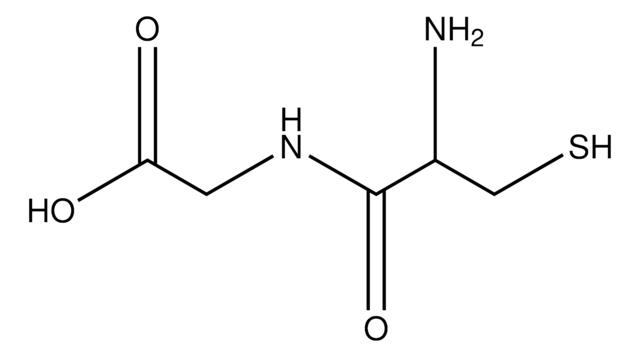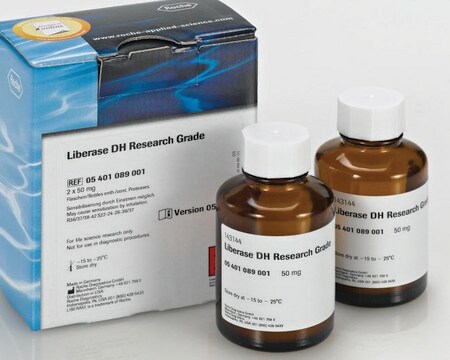353905
Glutathione Monoethyl Ester
>90% (TLC), solid, GSH-MEE transport, Calbiochem®
Synonim(y):
Glutathione Monoethyl Ester, γ-GCE, L-γ-Glutamyl-L-cysteinyl Ethyl Glycinate, GSH-MEE
About This Item
Polecane produkty
product name
Glutathione Monoethyl Ester, Cell-permeable derivative of glutathione (GSH) that undergoes hydrolysis by intracellular esterases to release GSH.
Poziom jakości
Próba
>90% (TLC)
Postać
solid
producent / nazwa handlowa
Calbiochem®
warunki przechowywania
OK to freeze
desiccated (hygroscopic)
kolor
white
rozpuszczalność
water: 50 mg/mL
Warunki transportu
ambient
temp. przechowywania
−20°C
InChI
1S/C12H21N3O6S/c1-2-21-10(17)5-14-11(18)8(6-22)15-9(16)4-3-7(13)12(19)20/h7-8,22H,2-6,13H2,1H3,(H,14,18)(H,15,16)(H,19,20)/t7-,8-/m0/s1
Klucz InChI
JKRODHBGNBKZLE-YUMQZZPRSA-N
Opis ogólny
Działania biochem./fizjol.
Effective transport of GSH-MEE
Opakowanie
Ostrzeżenie
Rekonstytucja
Inne uwagi
Martensson, J., et al. 1993. Proc. Natl. Acad. Sci. USA 90, 317.
Anderson, M.E., and Meister, A. 1989. Anal. Biochem. 183, 16.
Anderson, M.E., et al. 1985. Arch. Biochem. Biophys. 239, 538.
Wellner, V.P., et al. 1984. Proc. Natl. Acad. Sci. USA 81, 4732.
Puri, R.N., and Meister, A. 1983. Proc. Natl. Acad. Sci. USA 80, 5258.
Informacje prawne
Kod klasy składowania
11 - Combustible Solids
Klasa zagrożenia wodnego (WGK)
WGK 1
Temperatura zapłonu (°F)
Not applicable
Temperatura zapłonu (°C)
Not applicable
Certyfikaty analizy (CoA)
Poszukaj Certyfikaty analizy (CoA), wpisując numer partii/serii produktów. Numery serii i partii można znaleźć na etykiecie produktu po słowach „seria” lub „partia”.
Masz już ten produkt?
Dokumenty związane z niedawno zakupionymi produktami zostały zamieszczone w Bibliotece dokumentów.
Klienci oglądali również te produkty
Nasz zespół naukowców ma doświadczenie we wszystkich obszarach badań, w tym w naukach przyrodniczych, materiałoznawstwie, syntezie chemicznej, chromatografii, analityce i wielu innych dziedzinach.
Skontaktuj się z zespołem ds. pomocy technicznej







